Glycolic acid, an alpha hydroxy acid (AHA), has become an increasingly popular ingredient in skincare routines due to its multiple skincare benefits.
As an affordable and effective glycolic acid product, The Ordinary Glycolic Acid 7% Toning Solution exfoliates your skin. It helps improve skin clarity, balance uneven skin tone, and correct skin texture over time.

But if you think the only use for The Ordinary Glycolic Acid is your face, think again! You can use it on other areas of your body too.
It’s actually quite a steal for its low price and multiple uses!
So this guide on how to use The Ordinary Glycolic Acid 7% Toning Solution is designed to help you get the most out of this The Ordinary product while helping you minimize the risk of skin irritation.
This post contains affiliate links, and any purchases made through these links will result in a commission for me at no extra cost to you. Please read my Disclosure for additional information.
Before You Use The Ordinary Glycolic Acid
Before you use The Ordinary Glycolic Acid 7% Toning Solution, it’s essential to know that glycolic acid and other exfoliating acids can increase your skin’s sensitivity to the sun.
So always apply a broad-spectrum sunscreen with an SPF of 30 or higher while using this product and for seven days after.
Also, take a few minutes to patch test The Ordinary Glycolic Acid toner before using it on your face or body to avoid potential adverse reactions.
The Ordinary Glycolic Acid 7% Toning Solution
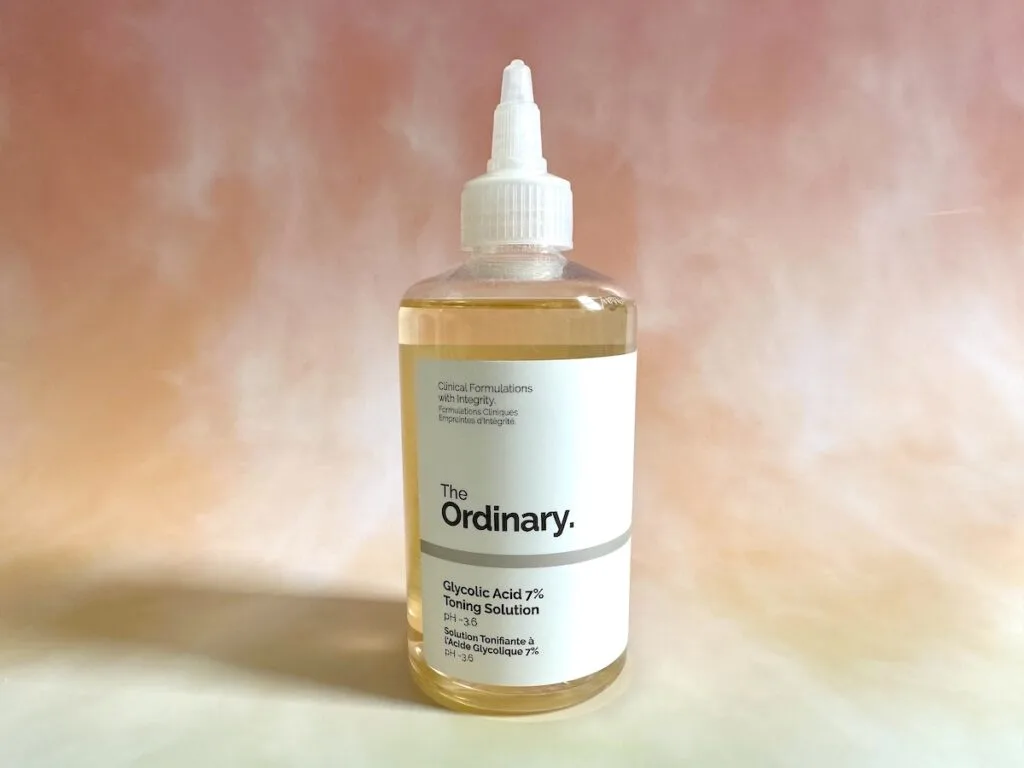
The Ordinary Glycolic Acid 7% Toning Solution is a popular acid toner due to its effective exfoliating properties and super affordable price point.
The toner contains 7% glycolic acid, a type of alpha hydroxy acid (AHA) derived from sugar cane and used in skincare for its multiple benefits.
AHAs help to exfoliate the top layer of your skin, encouraging new skin cell growth, reducing wrinkles and fine lines, improving texture, fading sun spots and acne scars, and making pores appear smaller and more refined.
In addition to glycolic acid, The Ordinary Glycolic Acid 7% Toning Solution also contains a Tasmanian Pepperberry derivative to help reduce irritation associated with AHA use, as well as aloe vera and cornflower flower water to soothe your skin.
Antioxidant ginseng root extract protects the skin from environmental stressors. Multiple amino acids and sugars help hydrate and moisturize your skin.
For more on my experience with this toner, please see my The Ordinary Glycolic Acid review post.
How To Use The Ordinary Glycolic Acid 7% Toning Solution
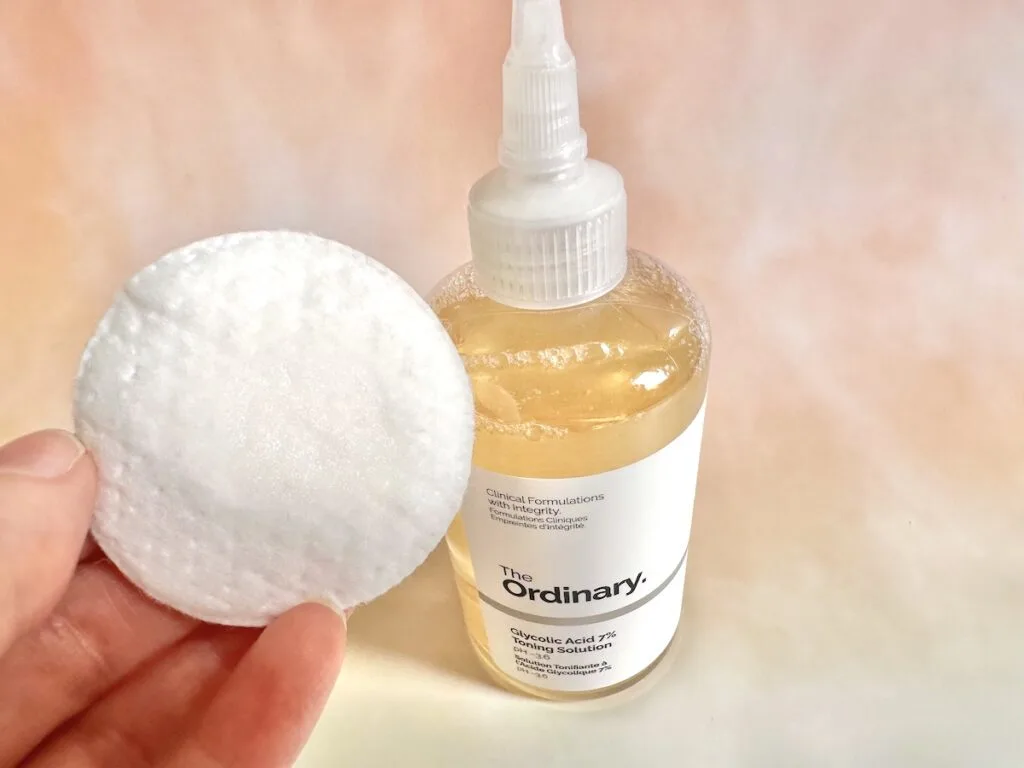
It is recommended that you start slowly by using The Ordinary Glycolic Acid toner once or twice weekly, gradually increasing the frequency as your skin becomes used to it, up to once daily if tolerated.
Do not use the acid toner on sensitive, peeling, compromised, or broken skin.
To get started, follow these simple steps to incorporate it into your skincare routine:
- Cleanse Your Skin: Wash your face with a gentle cleanser to remove any dirt, oil, or makeup. This step prepares your skin to absorb glycolic acid more effectively.
- Apply The Ordinary Glycolic Acid: After cleansing, dampen a cotton pad with The Ordinary’s Glycolic Acid 7% Toning Solution. Gently sweep it across your face (and neck if tolerated), making sure to avoid the eye area. It is important to note that glycolic acid is a potent exfoliant and should be used sparingly, especially if you have sensitive skin.
- Apply Serums and/or Treatments: Once the glycolic acid solution has been absorbed, apply any additional serums or treatments to enhance your skincare regimen. Be cautious when combining glycolic acid with other active ingredients, as it can cause irritation for certain skin types.
- Apply Moisturizer: After applying your serums, it’s essential to moisturize your skin. Look for a product containing nourishing ingredients like hyaluronic acid, ceramides, or glycerin to deliver intense hydration to your skin.
- Apply Sunscreen (AM): Glycolic acid can make your skin more sensitive to the sun, so it’s best to use it in your evening skincare routine. Whether you use it in the AM or PM, it is important to incorporate a broad-spectrum SPF sunscreen into your AM routine. Choose a product with at least SPF 30 to protect against harmful UV rays.
If you don’t want to use it on your entire face, you can also use The Ordinary Glycolic Acid 7% Toning Solution as a spot treatment for hyperpigmentation or acne. It helps to reduce the appearance of active breakouts and prevent future ones from forming.
Remember to be patient and consistent in your application, as positive results may take time to appear.
More Ways To Use The Ordinary Glycolic Acid 7% Toning Solution On Your Body
In addition to its primary use as a toner in your skincare routine, The Ordinary Glycolic Acid 7% Toning Solution has other versatile uses.
Here are some alternative ways to incorporate this effective glycolic acid toner into your beauty routine.
As A Deodorant
You can use The Ordinary Glycolic Acid as a natural deodorant. It helps eliminate odor-causing bacteria and exfoliate dead skin cells.
How does it work? Glycolic acid works by reducing the pH level of your skin, which helps neutralize odor-causing bacteria.
But as the temperature increases on your underarm skin, it may compromise your skin barrier, and the water from your sweat may reduce the effectiveness of glycolic acid. Also, glycolic acid doesn’t stop sweating, so it won’t keep you dry.
Glycolic acid may help underarm pigmentation, but if you use it too often, it may cause irritation, making hyperpigmentation worse.
If you still want to use glycolic acid as a deodorant, you can apply it with a cotton pad to clean dry underarm skin. Be sure to use a broad-spectrum sunscreen on areas exposed to sunlight since glycolic acid can make your skin sensitive to UV rays.
To Prevent Ingrown Hairs
The Ordinary Glycolic Acid is an effective treatment for preventing ingrown hairs by gently exfoliating the skin.
After cleansing the area, apply the toning solution to a cotton pad and delicately swipe over the area prone to ingrown hairs.
To Improve Dandruff
If you deal with dandruff, glycolic acid can help improve your scalp health. The tapered nozzle of the bottle is particularly useful for targeting the scalp.
Apply The Ordinary Glycolic Acid directly onto your scalp and massage it in gently. This helps to exfoliate the skin cells, reducing crustiness and flakes.
Be cautious and avoid contact with your eyes since the toner is a runny liquid.
Allow the toner to sit for about 30 minutes or so before washing and conditioning your hair. You can apply this treatment once or twice a week.
After a few weeks, you should see fewer flakes and dandruff.
To Reduce Keratosis Pilaris
Keratosis pilaris, a skin condition characterized by small, rough white bumps typically found on the back of the arms and thighs, can also be treated with The Ordinary Glycolic Acid.
Gently apply the solution to a cotton pad and sweep over affected areas to boost cell turnover, which helps reduce the appearance of keratosis pilaris.
For Dry Feet
The Ordinary Glycolic Acid 7% Toning Solution can also be used to soften dry, cracked feet.
Apply the solution to a cotton pad and swipe over clean, damp feet until they are fully coated with the toner.
Follow with a gentle moisturizer and socks, and after a few hours, you may be surprised at how much softer your feet are.
For Strawberry Legs
Strawberry legs are dark pores or hair follicles on the legs that appear when hair follicle oxidation occurs due to trapped oil, bacteria, and other debris.
Glycolic acid can help reduce the appearance of strawberry legs by exfoliating dead skin cells and unclogging pores.
Apply The Ordinary Glycolic Acid 7% Toning Solution with a cotton pad to clean damp skin and massage in a circular motion until fully absorbed.
The Ordinary Glycolic Acid Alternatives and Complementary Products
If The Ordinary Glycolic Acid isn’t the right concentration for you or you’d prefer a different product, there are several alternatives to consider:
Glycolic Acid Toners
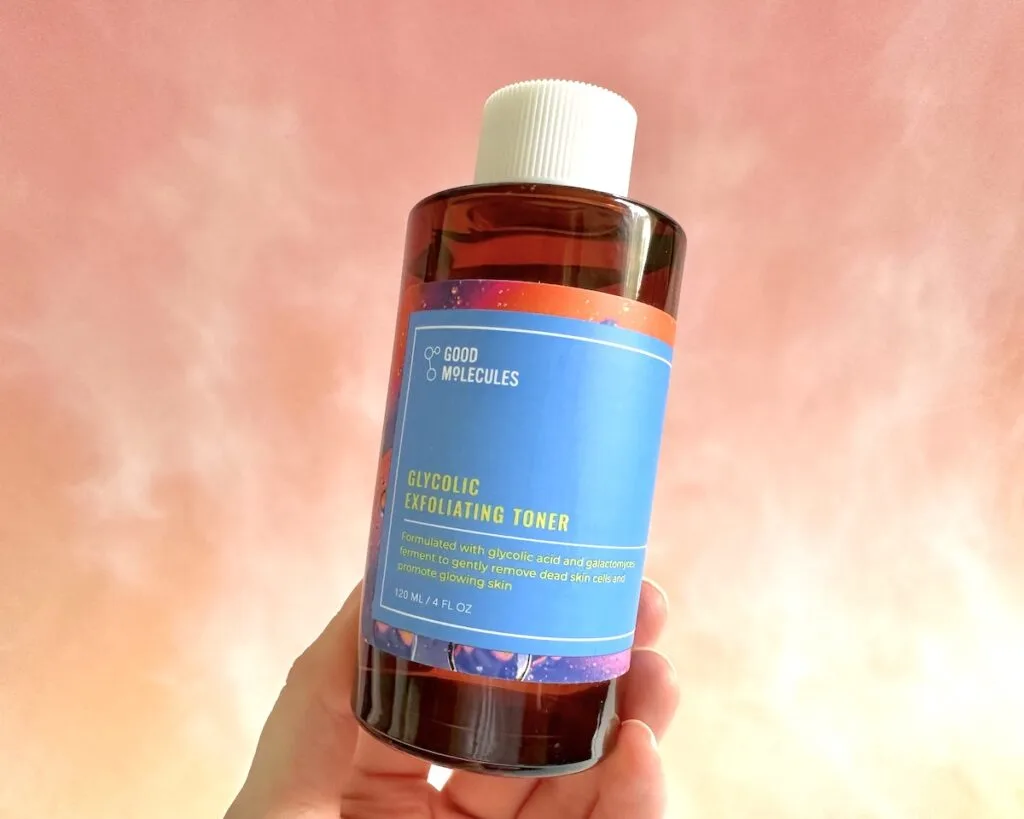
Good Molecules Glycolic Acid Exfoliating Toner is formulated with 3.5% glycolic acid plus 0.9% galactomyces ferment filtrate to exfoliate your skin’s surface while brightening and even out skin tone.
This glycolic toner is a great choice for beginners due to the low glycolic acid concentration.
Read more about Good Molecules and how they compare to The Ordinary products in this Good Molecules/The Ordinary comparison post.
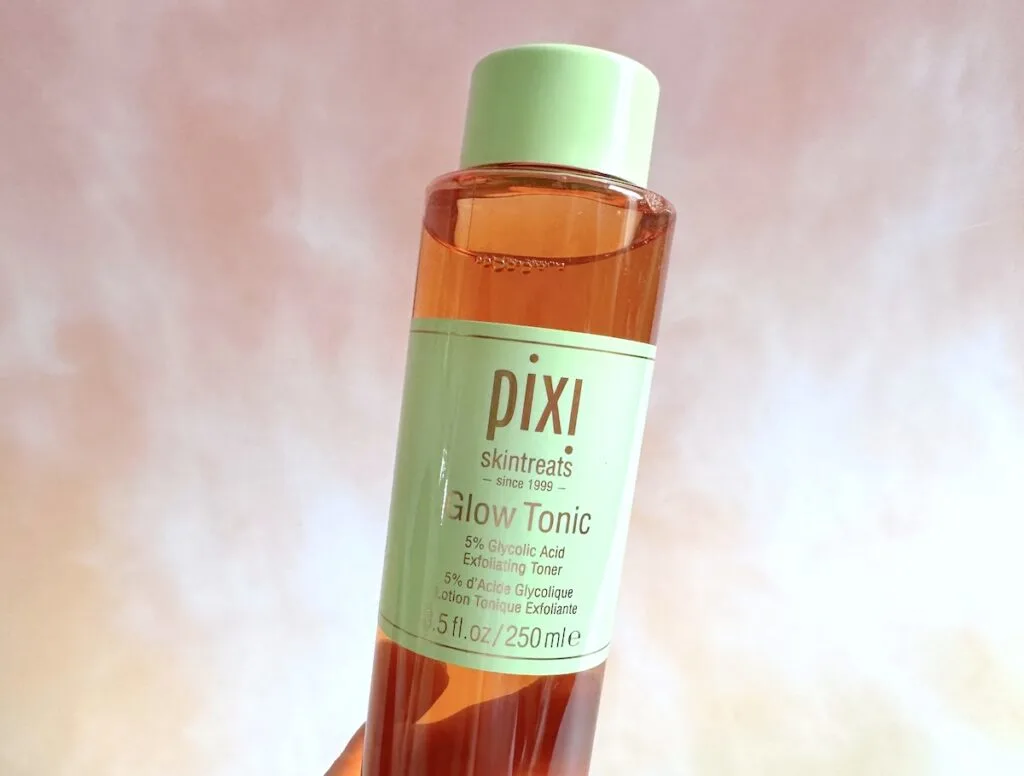
Another glycolic acid toner that offers similar benefits is Pixi Glow Tonic.
You can read about the similarities and differences between Pixi and The Ordinary in this post on The Ordinary Glycolic Acid vs Pixi Glow Tonic.
Lactic Acid

Another option is lactic acid, a type of AHA that works well for dry or sensitive skin. It helps lighten dark spots, reduce the appearance of wrinkles, and gently exfoliate the skin surface.
Lactic acid is known for its moisturizing properties and for treating dry, sensitive skin or those new to chemical exfoliants.
Mandelic Acid
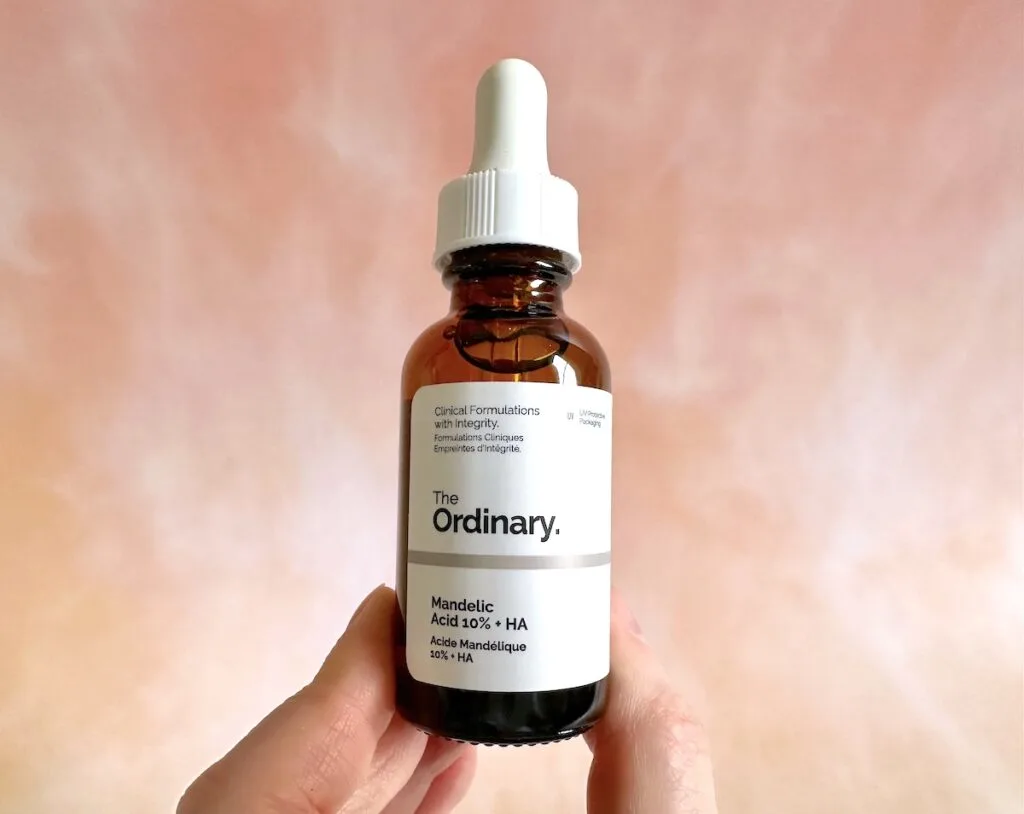
TRY IT: The Ordinary Mandelic Acid 10% + HA
If you have sensitive skin, you might prefer mandelic acid, an AHA derived from bitter almonds.
Mandelic acid has a larger molecular size than glycolic acid and lactic acid, making it less irritating and suitable for all skin types, including sensitive and acne-prone skin.
Salicylic Acid
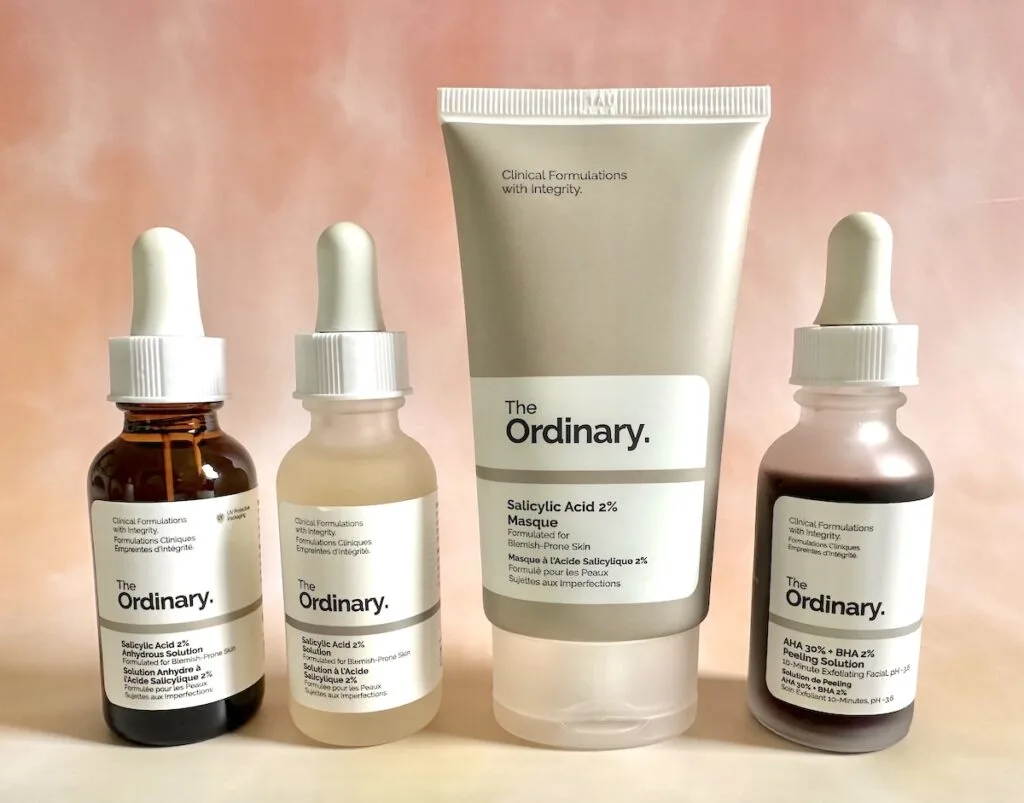
Another option is salicylic acid, a beta hydroxy acid (BHA) ideal for targeting sebum, blackheads, and acne. This oil-soluble acid penetrates deep into your pores and works especially well for oily or acne-prone skin types.
The Ordinary offers two salicylic acid 2% serums and a 2% salicylic acid rinse-off face masque that target blemishes and unclog pores.
The Ordinary AHA 30% + BHA 2% Peeling Solution contains glycolic acid, lactic acid, tartaric acid, citric acid, and salicylic acid. It is a potent rinse-off peel for experienced users of acid exfoliation.
Azelaic Acid
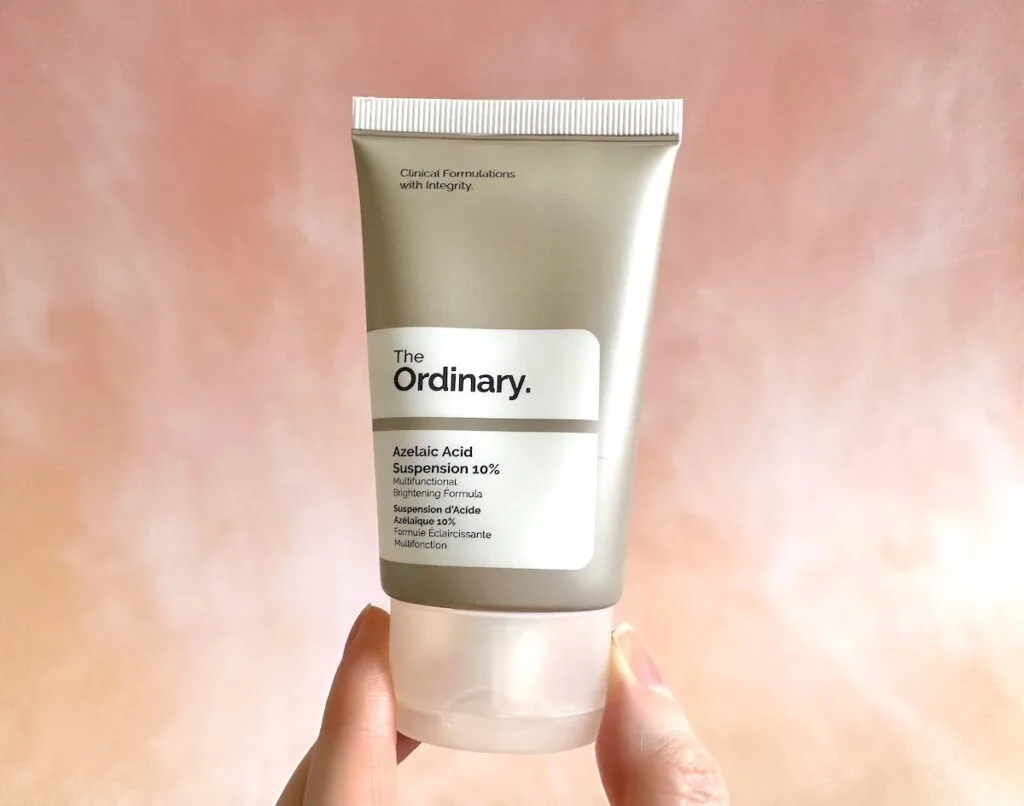
Another alternative is azelaic acid, an anti-inflammatory agent that helps reduce redness from acne and rosacea while also improving skin texture and tone.
Azelaic acid tends to be less irritating than glycolic acid, making it a better choice for sensitive skin.
Other Active Ingredients
You may also benefit from using other products in your skincare routine that complement glycolic acid.
Vitamin C

Vitamin C is a powerful antioxidant that helps to brighten your skin tone and can help decrease the appearance of acne scars and uneven skin tone.
It also offers protection against environmental stressors and free radical damage.
The Ordinary offers four pure vitamin C products at various strengths. If you want a completely customizable vitamin C product, try their pure vitamin C powder.
Please note that since pure vitamin C and glycolic acid are both acidic, depending on the concentration and your skin type, using them in the same skincare routine may cause irritation, so take it slow and be mindful of how your skin reacts.
See my guide to The Ordinary Vitamin C for more details on these vitamin C products.
Don’t Forget To Hydrate And Moisturize Your Skin
While this clinical study demonstrated that low levels (between 2% and 5%) of glycolic acid don’t compromise the skin barrier, using hydrating products with glycolic acid can help minimize irritation and strengthen your delicate skin barrier.
A hydrating serum helps balance out the exfoliating effects of glycolic acid and nourishes the skin after use.
Incorporating hyaluronic acid into your routine can help to boost your skin’s hydration levels. This ingredient is perfect for use alongside glycolic acid as it can soothe potential irritation caused by acid exfoliation.
And don’t forget to moisturize.
The Ordinary also has multiple moisturizers to lock in moisture and help keep your skin feeling hydrated post-exfoliation.
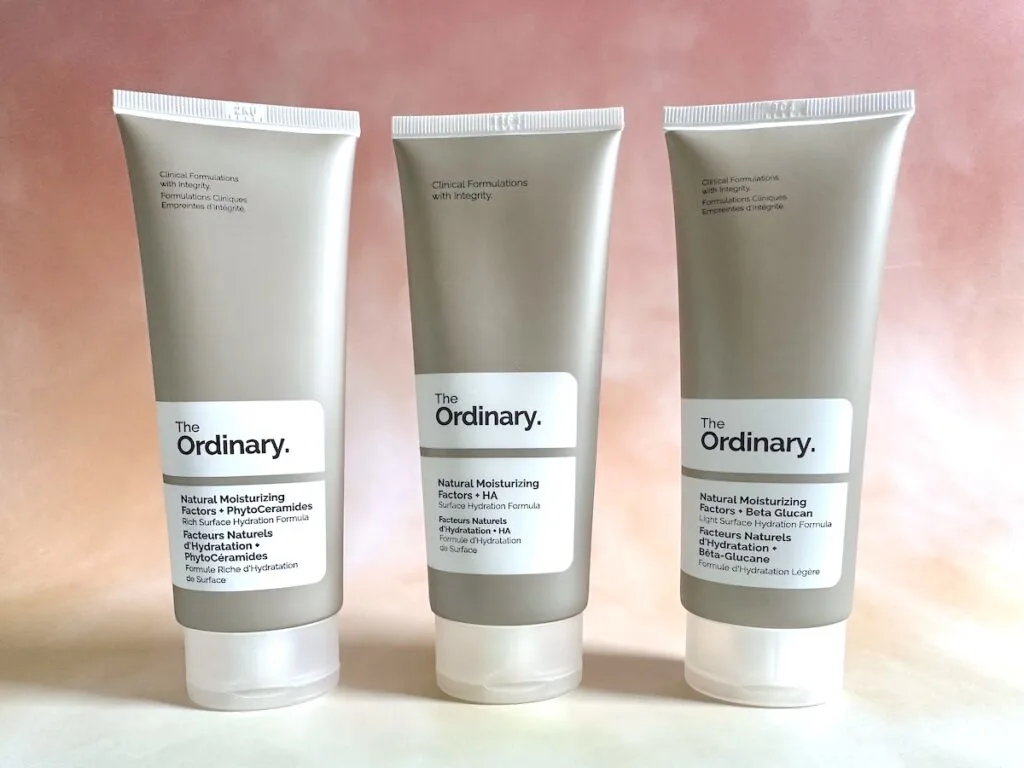
TRY IT:
- The Ordinary Natural Moisturizing Factors + HA (best for Normal to Combination Skin)
- The Ordinary Natural Moisturizing Factors + Beta Glucan (best for Normal to Oily Skin)
- The Ordinary Natural Moisturizing Factors + PhytoCeramides (best for Normal to Dry Skin)
Finally, don’t forget to use sunscreen every day to protect your skin from the sun’s harmful rays.
Sun exposure can further irritate sensitive skin or worsen glycolic acid side effects, so make sure you wear adequate protection when outdoors.
You can read about my picks for the best drugstore mineral sunscreens here.
The Benefits of Glycolic Acid
Glycolic acid, an alpha-hydroxy acid (AHA), is a water-soluble acid derived from sugar cane and a versatile and powerful ingredient that can greatly benefit your skin.
Here are some of the main benefits of glycolic acid for your skin:
- Brightens Dull Skin: Glycolic acid helps remove dead skin cells from the surface of your skin, revealing a brighter complexion.
- Reduces The Look Of Hyperpigmentation, Dark Spots, and Uneven Skin Tone: With regular use, glycolic acid can help reduce the appearance of sunspots, age spots, and other types of hyperpigmentation. By gently exfoliating the outer layer of your skin, glycolic acid allows for a more even distribution of melanin (pigment), resulting in a brighter and more uniform complexion.
- Improves Texture: Glycolic acid can help smooth out rough patches and improve overall skin texture.
- Reduces The Appearance Of Wrinkles: By promoting collagen production and increasing cell turnover, glycolic acid can help reduce wrinkles and fine lines over time.
- Reduces Acne: The exfoliating properties of glycolic acid help clear clogged pores, which can help reduce acne and blemishes.
- Treats Dry Skin: By removing dead skin cells from the surface of your skin, glycolic acid helps moisturizers penetrate more deeply, providing long-lasting hydration.
Potential Side Effects of Glycolic Acid
Since glycolic acid is the smallest AHA, glycolic acid penetrates more deeply into the skin than other AHAs, which can cause side effects.
It is crucial to start with a lower concentration and gradually increase as your skin becomes more accustomed to the acid.
One of the most common side effects is redness and/or irritation. When using glycolic acid for the first time, your skin may feel a bit tingly or uncomfortable, but this sensation should decrease as your skin adjusts to the product.
In some cases, glycolic acid may cause sensitivity and/ or burning sensations. This issue is more likely to arise when using products with higher concentrations of glycolic acid or if the skin is already irritated or sensitive.
If you experience any of these side effects, discontinue its use and consult your physician.
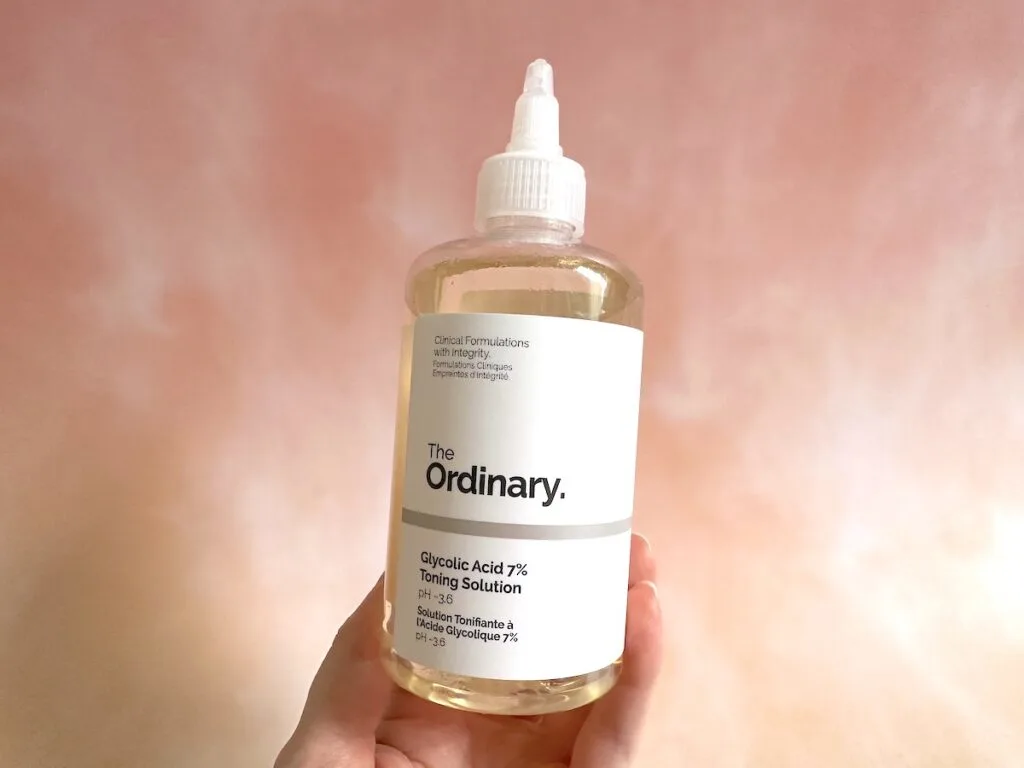
Who Should Use Glycolic Acid?
It’s important to understand if glycolic acid is suitable for your skin type and needs before incorporating it into your skin care routine.
If you have oily skin, glycolic acid is a great choice due to its exfoliating properties, as it helps unclog pores and reduce oiliness. Its ability to refine skin texture and reduce the look of enlarged pores makes it an excellent option if you’re seeking a clearer complexion.
Glycolic acid is also an excellent choice for acne-prone skin since it improves dead skin cell turnover and unclogs pores, preventing acne-causing bacteria buildup.
Hyperpigmentation and sun damage can be addressed by incorporating glycolic acid into your routine. It helps lighten dark spots and even out your skin tone, making it suitable for skin discoloration concerns.
If you have dry skin, glycolic acid can be beneficial. It helps increase cell turnover and slough away dead skin cells, revealing a smoother, more hydrated complexion. However, make sure to follow up with a good moisturizer to prevent over-drying.
If you have sensitive skin should tread carefully when using glycolic acid. Glycolic acid can cause redness, itching, and discomfort if your skin is particularly reactive.
Start with a lower concentration product, 5% or less, and gradually increase the strength as your skin tolerates. (My somewhat sensitive skin can’t tolerate higher concentrations of glycolic acid.)
You should be cautious when using glycolic acid if you have a compromised skin barrier. It may cause irritation and potentially worsen your skin’s condition.
Lastly, glycolic acid is beneficial in combating visible signs of aging. It helps stimulate collagen production (over long-term use), which can help reduce the appearance of fine lines and wrinkles for a more youthful and radiant complexion.
Always listen to your skin’s needs and adjust your usage as necessary. When in doubt, consult a professional to ensure you use glycolic acid effectively and safely.
For more details on combining these and other The Ordinary products, be sure to check out these related posts:
The Bottom Line
The Ordinary Glycolic Acid 7% Toning Solution is an effective and affordable product that can be used to improve many skin conditions, including wrinkles, fine lines, acne scars, sun spots, enlarged pores, keratosis pilaris, and dandruff.
While it has many applications, it may not be suitable for everyone, as it can irritate certain skin types.
Start slowly and gradually increase your usage frequency as your skin adjusts to the glycolic acid. Above all else, always apply broad-spectrum sunscreen when using any exfoliant or acid toner.
Before you know it, you’ll be seeing the positive impact of this affordable and effective AHA product on your skin!
Thanks for reading!

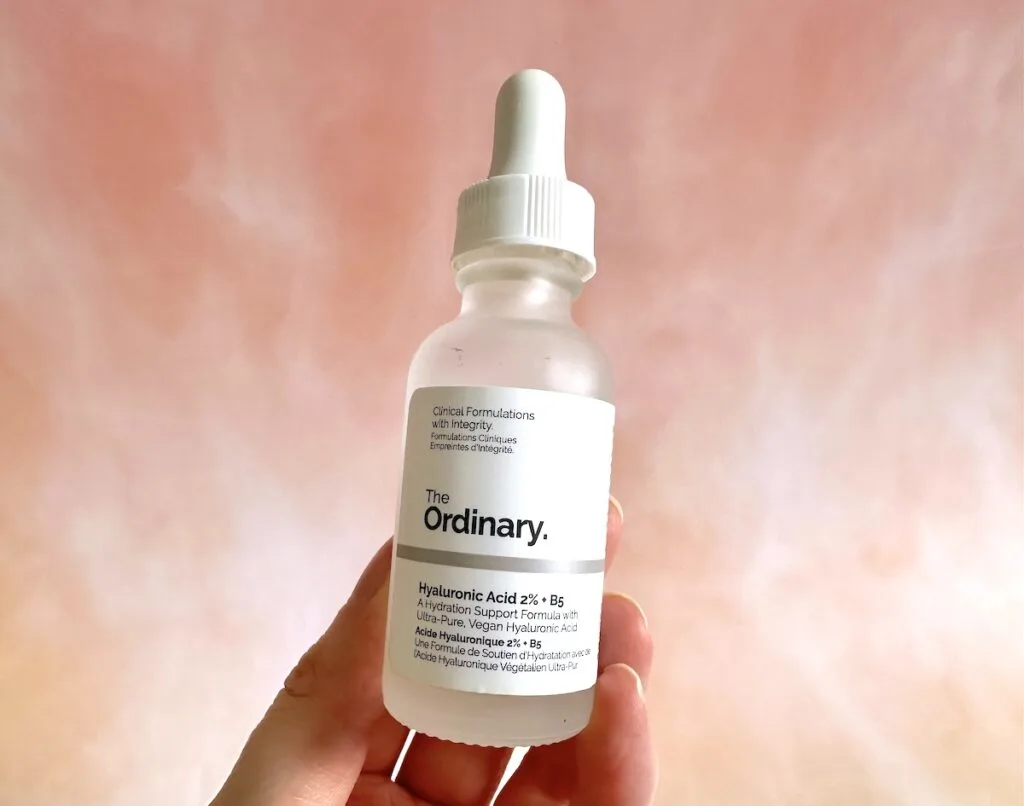

Giselle Marash
Tuesday 10th of October 2023
Hmm, information is a lot to take in but very informative for anyone who wants to begin the use of the ordinary line. Continue to do your thing Sarah and keep up the good work you have started to educate juniors in the facial business.